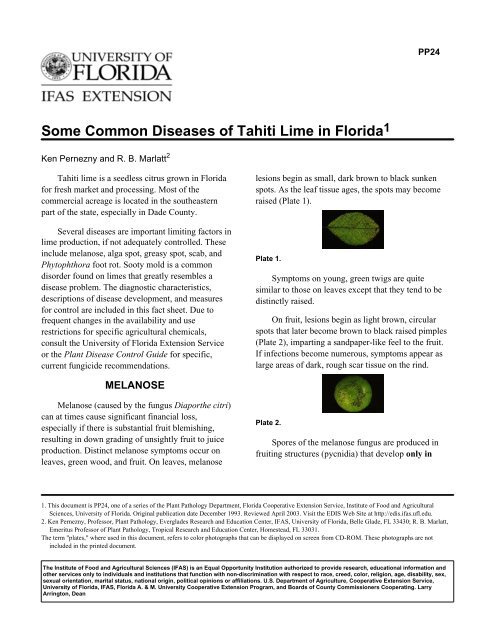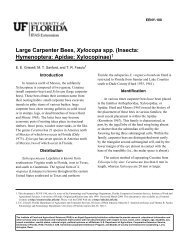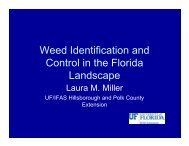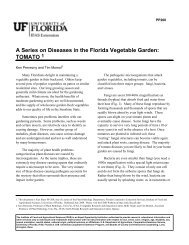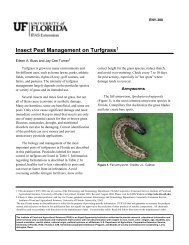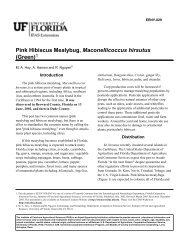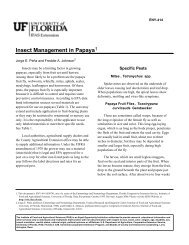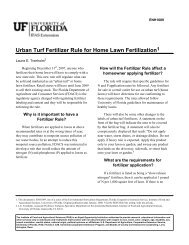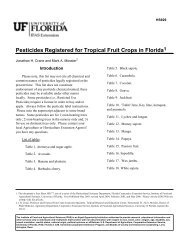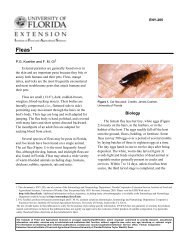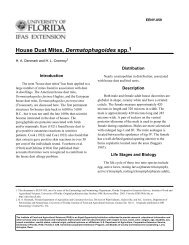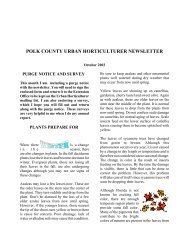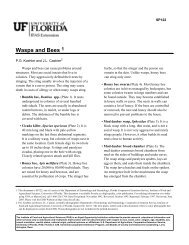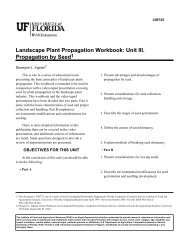Some Common Diseases of Tahiti Lime in Florida - University of ...
Some Common Diseases of Tahiti Lime in Florida - University of ...
Some Common Diseases of Tahiti Lime in Florida - University of ...
Create successful ePaper yourself
Turn your PDF publications into a flip-book with our unique Google optimized e-Paper software.
PP24<br />
<strong>Some</strong> <strong>Common</strong> <strong>Diseases</strong> <strong>of</strong> <strong>Tahiti</strong> <strong>Lime</strong> <strong>in</strong> <strong>Florida</strong> 1<br />
Ken Pernezny and R. B. Marlatt 2<br />
<strong>Tahiti</strong> lime is a seedless citrus grown <strong>in</strong> <strong>Florida</strong><br />
for fresh market and process<strong>in</strong>g. Most <strong>of</strong> the<br />
commercial acreage is located <strong>in</strong> the southeastern<br />
part <strong>of</strong> the state, especially <strong>in</strong> Dade County.<br />
Several diseases are important limit<strong>in</strong>g factors <strong>in</strong><br />
lime production, if not adequately controlled. These<br />
<strong>in</strong>clude melanose, alga spot, greasy spot, scab, and<br />
Phytophthora foot rot. Sooty mold is a common<br />
disorder found on limes that greatly resembles a<br />
disease problem. The diagnostic characteristics,<br />
descriptions <strong>of</strong> disease development, and measures<br />
for control are <strong>in</strong>cluded <strong>in</strong> this fact sheet. Due to<br />
frequent changes <strong>in</strong> the availability and use<br />
restrictions for specific agricultural chemicals,<br />
consult the <strong>University</strong> <strong>of</strong> <strong>Florida</strong> Extension Service<br />
or the Plant Disease Control Guide for specific,<br />
current fungicide recommendations.<br />
lesions beg<strong>in</strong> as small, dark brown to black sunken<br />
spots. As the leaf tissue ages, the spots may become<br />
raised (Plate 1).<br />
Plate 1.<br />
Symptoms on young, green twigs are quite<br />
similar to those on leaves except that they tend to be<br />
dist<strong>in</strong>ctly raised.<br />
On fruit, lesions beg<strong>in</strong> as light brown, circular<br />
spots that later become brown to black raised pimples<br />
(Plate 2), impart<strong>in</strong>g a sandpaper-like feel to the fruit.<br />
If <strong>in</strong>fections become numerous, symptoms appear as<br />
large areas <strong>of</strong> dark, rough scar tissue on the r<strong>in</strong>d.<br />
MELANOSE<br />
Melanose (caused by the fungus Diaporthe citri)<br />
can at times cause significant f<strong>in</strong>ancial loss,<br />
especially if there is substantial fruit blemish<strong>in</strong>g,<br />
result<strong>in</strong>g <strong>in</strong> down grad<strong>in</strong>g <strong>of</strong> unsightly fruit to juice<br />
production. Dist<strong>in</strong>ct melanose symptoms occur on<br />
leaves, green wood, and fruit. On leaves, melanose<br />
Plate 2.<br />
Spores <strong>of</strong> the melanose fungus are produced <strong>in</strong><br />
fruit<strong>in</strong>g structures (pycnidia) that develop only <strong>in</strong><br />
1. This document is PP24, one <strong>of</strong> a series <strong>of</strong> the Plant Pathology Department, <strong>Florida</strong> Cooperative Extension Service, Institute <strong>of</strong> Food and Agricultural<br />
Sciences, <strong>University</strong> <strong>of</strong> <strong>Florida</strong>. Orig<strong>in</strong>al publication date December 1993. Reviewed April 2003. Visit the EDIS Web Site at http://edis.ifas.ufl.edu.<br />
2. Ken Pernezny, Pr<strong>of</strong>essor, Plant Pathology, Everglades Research and Education Center, IFAS, <strong>University</strong> <strong>of</strong> <strong>Florida</strong>, Belle Glade, FL 33430; R. B. Marlatt,<br />
Emeritus Pr<strong>of</strong>essor <strong>of</strong> Plant Pathology, Tropical Research and Education Center, Homestead, FL 33031.<br />
The term "plates," where used <strong>in</strong> this document, refers to color photographs that can be displayed on screen from CD-ROM. These photographs are not<br />
<strong>in</strong>cluded <strong>in</strong> the pr<strong>in</strong>ted document.<br />
The Institute <strong>of</strong> Food and Agricultural Sciences (IFAS) is an Equal Opportunity Institution authorized to provide research, educational <strong>in</strong>formation and<br />
other services only to <strong>in</strong>dividuals and <strong>in</strong>stitutions that function with non-discrim<strong>in</strong>ation with respect to race, creed, color, religion, age, disability, sex,<br />
sexual orientation, marital status, national orig<strong>in</strong>, political op<strong>in</strong>ions or affiliations. U.S. Department <strong>of</strong> Agriculture, Cooperative Extension Service,<br />
<strong>University</strong> <strong>of</strong> <strong>Florida</strong>, IFAS, <strong>Florida</strong> A. & M. <strong>University</strong> Cooperative Extension Program, and Boards <strong>of</strong> County Commissioners Cooperat<strong>in</strong>g. Larry<br />
Arr<strong>in</strong>gton, Dean
<strong>Some</strong> <strong>Common</strong> <strong>Diseases</strong> <strong>of</strong> <strong>Tahiti</strong> <strong>Lime</strong> <strong>in</strong> <strong>Florida</strong> 2<br />
dead wood. The spores are embedded <strong>in</strong> a sticky<br />
matrix and, for all practical purposes, are released<br />
only by splash<strong>in</strong>g ra<strong>in</strong>fall, after which they can <strong>in</strong>fect<br />
young leaves, green twigs, and fruit. Subsequent<br />
lesions on liv<strong>in</strong>g tissue do not serve as <strong>in</strong>oculum<br />
sources, s<strong>in</strong>ce no fruit<strong>in</strong>g structures are formed <strong>in</strong><br />
them.<br />
S<strong>in</strong>ce dead wood is the primary source <strong>of</strong><br />
melanose spores, removal <strong>of</strong> dead wood is a<br />
significant control factor. It is important to note that<br />
serious out breaks <strong>of</strong> melanose usually occur after<br />
freezes that result <strong>in</strong> a lot <strong>of</strong> dead wood <strong>in</strong> groves.<br />
Copper fungicides are important <strong>in</strong> controll<strong>in</strong>g<br />
melanose, especially those applied dur<strong>in</strong>g the ra<strong>in</strong>y<br />
season.<br />
ALGAL DISEASE (ALGA SPOT, RED<br />
ALGAL DISEASE)<br />
This disease is caused by a parasitic alga,<br />
Cephaleuros. This organism has a wide host range<br />
among tropical and subtropical trees, but is a<br />
particularly serious problem on <strong>Tahiti</strong> lime. Lesions<br />
on leaves are roughly circular, raised, and<br />
greenish-gray <strong>in</strong> color. The alga will eventually<br />
produce rust-colored microscopic "spores" on the<br />
surface <strong>of</strong> the leaf spots, giv<strong>in</strong>g the spots a reddish<br />
appearance (Plate 3).<br />
sprays are <strong>in</strong>cluded <strong>in</strong> the disease control program, it<br />
is usually well controlled. Aga<strong>in</strong>, copper sprays <strong>in</strong> the<br />
ra<strong>in</strong>y season, especially <strong>in</strong> June, are most effective.<br />
GREASY SPOT<br />
Greasy spot, caused by the fungus<br />
Mycosphaerella citri, is a major disease <strong>of</strong> <strong>Tahiti</strong><br />
lime. Severe defoliation and subsequent long-term<br />
loss <strong>of</strong> tree vigor can result if it is not adequately<br />
controlled.<br />
Infection <strong>of</strong> new leaves occurs from <strong>in</strong>vasion by<br />
spores released <strong>in</strong> diseased and decompos<strong>in</strong>g lime<br />
leaves on the grove floor. S<strong>in</strong>ce the decompos<strong>in</strong>g<br />
leaves require alternate periods <strong>of</strong> wett<strong>in</strong>g and dry<strong>in</strong>g<br />
for spore release, most <strong>in</strong>fection probably occurs <strong>in</strong><br />
the summer.<br />
Fungal <strong>in</strong>vasion occurs through stomates on the<br />
underside <strong>of</strong> the leaves. The symptoms beg<strong>in</strong> as<br />
small, localized water-logged areas on the underside<br />
<strong>of</strong> leaves that subsequently blister. These<br />
under-surface areas then beg<strong>in</strong> to turn orange to light<br />
brown (Plate 5), with yellow<strong>in</strong>g <strong>of</strong> the upper leaf<br />
surface. With time, <strong>in</strong>fections turn dark brown to<br />
black, with a def<strong>in</strong>ite greasy look (Plate 6). Infected<br />
leaves very <strong>of</strong>ten drop prematurely.<br />
Plate 5.<br />
Plate 3.<br />
The alga may also attack branches, and bark<br />
splitt<strong>in</strong>g may occur. If wood <strong>in</strong>fections become<br />
severe, girdl<strong>in</strong>g and death <strong>of</strong> branches may result. The<br />
appearance <strong>of</strong> the masses <strong>of</strong> red "spores" on the wood<br />
(Plate 4) is highly diagnostic.<br />
Plate 4.<br />
Algal disease became much more prevalent <strong>in</strong><br />
<strong>Florida</strong> with the advent <strong>of</strong> organic fungicides (such<br />
as benomyl and the dithiocarbamates). When copper<br />
Plate 6.<br />
Fruit <strong>in</strong>fection can occur on <strong>Tahiti</strong> lime, but does<br />
not seem to be that common.<br />
Effective control <strong>of</strong> greasy spot can be obta<strong>in</strong>ed<br />
with sprays <strong>of</strong> copper, benomyl, or benomyl plus oil.<br />
When greasy spot levels are low, oil alone may be<br />
sufficient. Homeowners should benefit from a<br />
sanitation program aimed at clean<strong>in</strong>g up and<br />
remov<strong>in</strong>g fallen, <strong>in</strong>fected leaves from around the<br />
base <strong>of</strong> their lime trees. See Plant Pathology Fact
<strong>Some</strong> <strong>Common</strong> <strong>Diseases</strong> <strong>of</strong> <strong>Tahiti</strong> <strong>Lime</strong> <strong>in</strong> <strong>Florida</strong> 3<br />
Sheet No. 9 for a more detailed description <strong>of</strong> citrus<br />
greasy spot.<br />
SCAB<br />
Scab is caused by the fungus Els<strong>in</strong>oe fawcetti.<br />
<strong>Tahiti</strong> lime is not as susceptible to scab as some other<br />
citrus. However, sporadic outbreaks can cause<br />
economic loss. The disease is most common <strong>in</strong><br />
groves where <strong>Tahiti</strong> lime has been grafted onto rough<br />
lemon rootstock. Rough lemon is extremely<br />
susceptible to this fungus and <strong>in</strong>oculum can build up<br />
on suckers aris<strong>in</strong>g at the base <strong>of</strong> the tree.<br />
Infections on lime leaves appear as light-colored,<br />
raised areas. Severely <strong>in</strong>fected leaves are distorted.<br />
Infections <strong>of</strong> fruit appear as prom<strong>in</strong>ent,<br />
light-colored, raised areas (Plate 7), that throw fruit<br />
out <strong>of</strong> grade.<br />
Plate 7.<br />
Cultural controls are very important <strong>in</strong><br />
management <strong>of</strong> scab. If rough lemon has been used<br />
as the rootstock, emerged lemon sprouts must be<br />
promptly pruned out. Use <strong>of</strong> marcots (airlayers) will,<br />
<strong>of</strong> course, elim<strong>in</strong>ate the rough lemon problem.<br />
Copper and benomyl sprays are also recommended.<br />
Plate 8.<br />
rootstock. Under flood<strong>in</strong>g conditions the feeder roots<br />
<strong>of</strong> lime trees may be attacked by these fungi,<br />
result<strong>in</strong>g <strong>in</strong> a root rot. Severe <strong>in</strong>fection may kill trees.<br />
Control <strong>of</strong> foot rot is primarily cultural. It is<br />
important to prevent disease entry <strong>in</strong>to groves by<br />
strict sanitation <strong>in</strong> the propagation nursery. Injuries to<br />
tree trunks should be avoided, because they can be<br />
sites for fungal entry. Weeds should be adequately<br />
controlled to prevent moisture from build<strong>in</strong>g up<br />
around tree trunks.<br />
SOOTY MOLD<br />
Sooty mold is not, strictly speak<strong>in</strong>g, a "disease"<br />
<strong>of</strong> lime, s<strong>in</strong>ce it does not <strong>in</strong>volve the <strong>in</strong>vasion and<br />
colonization <strong>of</strong> the host by a pathogenic<br />
micro-organism. Instead, it is a reflection <strong>of</strong> an attack<br />
by pest <strong>in</strong>sects, especially the citrus whitefly. While<br />
whiteflies and related <strong>in</strong>sects feed on lime leaves and<br />
fruit, they secrete a thick, sweet, sticky honeydew that<br />
is promptly <strong>in</strong>vaded by the sooty mold fungus. The<br />
result is a black discoloration (due to the color <strong>of</strong> the<br />
fungus) over leaf (Plate 9) and fruit surfaces. An<br />
observer can usually identify sooty mold, because it<br />
will rub <strong>of</strong>f on the f<strong>in</strong>gers.<br />
PHYTOPHTHORA FOOT ROT<br />
Foot rot is a soilborne fungus disease caused by<br />
either Phytophthora citrophthora or Phytophthora<br />
parasitica. The latter fungus is particularly wide<br />
spread <strong>in</strong> the rock soils <strong>of</strong> Dade County. These fungi<br />
damage trees by <strong>in</strong>vad<strong>in</strong>g woody tissue at or below<br />
the soil l<strong>in</strong>e.<br />
The most serious aspect <strong>of</strong> this disease occurs<br />
when Phytophthora <strong>in</strong>vades at the tree base,<br />
produc<strong>in</strong>g large cankers (Plate 8). Trees become<br />
chlorotic, and dieback beg<strong>in</strong>s.<br />
Plate 9.<br />
It is thought that sooty mold has little, if any<br />
effect on the general health <strong>of</strong> the lime tree, and it is<br />
considered <strong>of</strong> economic importance only when the<br />
black growth builds up to a po<strong>in</strong>t where it cannot be<br />
easily cleaned <strong>of</strong>f fruit at the pack<strong>in</strong>g house.<br />
Rough lemon rootstock is susceptible to foot rot;<br />
the <strong>in</strong>cidence <strong>of</strong> the disease is noticeably lower <strong>in</strong><br />
marcot trees and those trees on Citrus macrophylla


